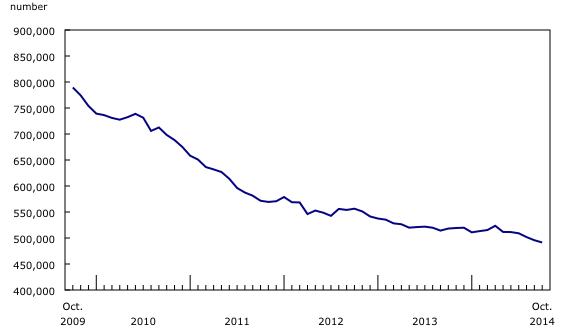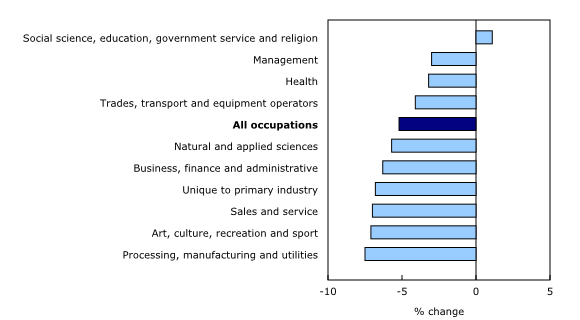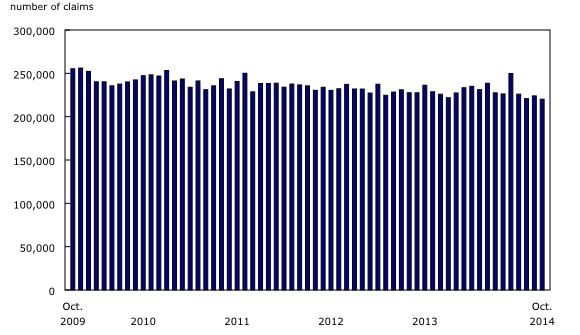Employment Insurance, October 2014
Archived Content
Information identified as archived is provided for reference, research or recordkeeping purposes. It is not subject to the Government of Canada Web Standards and has not been altered or updated since it was archived. Please "contact us" to request a format other than those available.
Released: 2014-12-18
The number of people receiving regular Employment Insurance (EI) benefits in October was 491,400, little changed from the previous month. Compared with October 2013, the number of beneficiaries decreased 26,800 or 5.2%.
All provinces saw little change in October in the number of people receiving regular benefits, except for British Columbia, where there was a marked decline compared with September.
The change in the number of regular EI beneficiaries reflects various situations, including people becoming beneficiaries, people going back to work and people no longer receiving regular benefits.
Provincial and metropolitan area overview
The number of beneficiaries in British Columbia fell 10.3% to 50,500 in October, more than offsetting the previous months' increase. In Vancouver, the number of beneficiaries decreased 13.3% to 19,900, reversing the increase in September. Victoria (-6.3%) and Kelowna (-5.6%) also had fewer beneficiaries in October, while the number increased in Abbotsford–Mission (+5.1%).
While the other provinces saw little or no change in the number of beneficiaries, this was not the case in some of the metropolitan areas within these provinces.
In October, 25,200 people received regular Employment Insurance benefits in Nova Scotia, with Halifax posting a decline of 2.6%. The decrease in Halifax continued a downward trend that began in the spring.
In Quebec, 150,000 people received benefits in October. There were more beneficiaries in the metropolitan area of Saguenay (+5.0%). In Montréal, the number of people receiving regular benefits edged up to 55,800.
The number of people receiving regular EI benefits in Ontario was 144,000 in October. However, there were fewer beneficiaries in Kitchener–Cambridge–Waterloo (-3.1%), as well as Windsor (-2.7%). At the same time, the number of beneficiaries increased in Barrie (+9.7%). In Toronto, the number of beneficiaries edged up to 55,700.
The number of people receiving benefits in Saskatchewan totalled 10,800, with Regina reporting a 1.5% increase in beneficiaries.
In Alberta, 28,700 people received regular benefits in October, with Edmonton posting a slight decline of 1.2%.
Regular Employment Insurance beneficiaries by occupation
In the 12 months to October, the number of beneficiaries in all occupation groups combined declined 5.2%. There were fewer people receiving benefits in 9 of the 10 major occupation groups, most notably in occupations unique to processing, manufacturing and utilities (-7.5%); occupations in art, culture, recreation and sport (-7.1%); sales and service occupations (-7.0%); as well as occupations unique to primary industry (-6.8%).
People whose last occupation was in social science, education, government service and religion made up the only group to report an increase in beneficiaries (+1.1%).
Employment Insurance beneficiaries in major demographic groups
In October, the number of beneficiaries decreased among women aged 25 to 54 (-2.7%) and women aged 55 and over (-1.8%). Also, fewer men aged 15 to 24 (-1.8%) received benefits.
On a year-over-year basis, the fastest rate of decline in the number of beneficiaries continued to be among people aged 15 to 24, down 8.7% for women and 7.6% for men. Over the same period, the number of beneficiaries among men aged 25 to 54 fell by 6.4%, a slightly faster rate of decline than the 6.0% decrease observed for women in the same age group. Among people aged 55 and older, men posted a slight decline of 1.1%, while there was little change for women.
Employment Insurance claims
Nationally, there were fewer Employment Insurance claims in October compared with September, down 1.7% to 220,200. The number of claims provides an indication of the number of people who could become beneficiaries.
Provincially, claims fell notably in Alberta (-6.3%), Saskatchewan (-5.7%), British Columbia (-3.7%) and Manitoba (-3.3%). There were also fewer claims in Newfoundland and Labrador (-1.6%), New Brunswick (-1.6%) and Nova Scotia (-1.5%), while there was little change in the remaining provinces.
Note to readers
Geographic boundaries have been updated from the 2006 edition of the Standard Geographical Classification to the 2011 edition. The update mainly affects boundaries of census metropolitan areas and census agglomerations.
New seasonally adjusted data by sex, age, census metropolitan area, census agglomeration and occupation are also available.
CANSIM tables 276-0005, 276-0015, 276-0030, 276-0031 and 276-0032 have been terminated and replaced by tables 276-0017, 276-0018, 276-0033, 276-0034 and 276-0035, respectively. Also, data on new benefit programs for self-employed and for parents of critically ill children have been added to 276-0017 (unadjusted for seasonality) and 276-0018 (seasonally adjusted). Finally, CANSIM table 276-0016 has been terminated.
To maintain consistency, all Employment Insurance (EI) data series have been revised historically back to January 1997.
Note to readers
Regular EI benefits are available to eligible individuals who lose their jobs and who are available for and able to work, but cannot find a job. To receive EI benefits, individuals must first submit a claim. The number of claims provides an indication of the number of people who could become beneficiaries.
There is always a certain proportion of unemployed people who do not qualify for benefits. Some unemployed people have not contributed to the program because they have not worked in the past 12 months or their employment is not insured. Other unemployed people have contributed to the program but do not meet the eligibility criteria, such as workers who left their job voluntarily or those who did not accumulate enough hours of work to receive benefits.
All data in this release are seasonally adjusted. For more information on seasonal adjustment, see Seasonally adjusted data – Frequently asked questions.
EI statistics are produced from administrative data sources provided by Service Canada and Employment and Social Development Canada. These statistics may, from time to time, be affected by changes to the Employment Insurance Act or administrative procedures.
The number of regular EI beneficiaries and the number of claims received for the current and previous month are subject to revision.
The number of beneficiaries is a measure of all people who received EI benefits from October 12 to 18. This period coincides with the reference week of the Labour Force Survey (LFS). However, initial and renewal claims data are for the entire month.
EI statistics indicate the number of people who received EI benefits, and should not be confused with LFS data, which provide information on the total number of unemployed people.
Data tables are also now available online. From the Browse by key resource module of our website under Summary tables, choose Subject, then Labour.
Data on Employment Insurance for November 2014 will be released on January 22, 2015.
Contact information
For more information, contact us (toll-free 1-800-263-1136; 514-283-8300; infostats@statcan.gc.ca).
To enquire about the concepts, methods or data quality of this release, contact Vincent Ferrao (613-951-4750; vincent.ferrao@statcan.gc.ca), Labour Statistics Division.
- Date modified:




